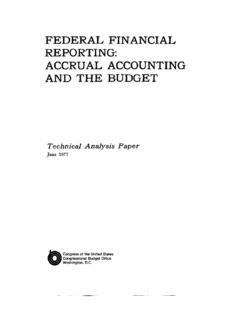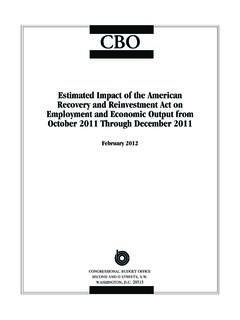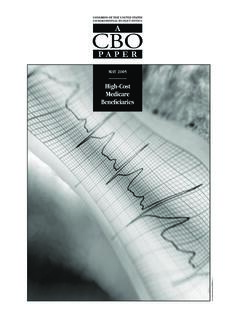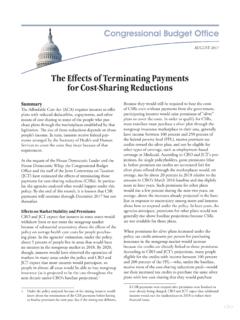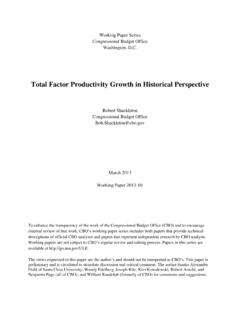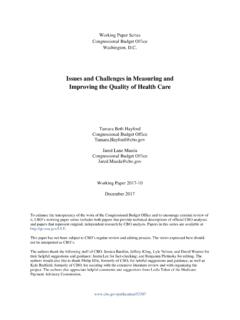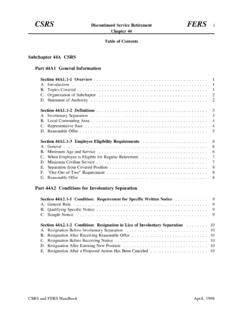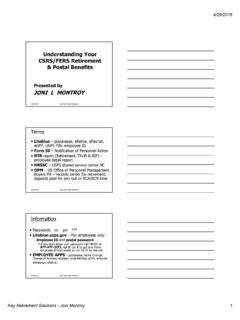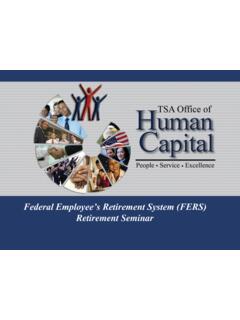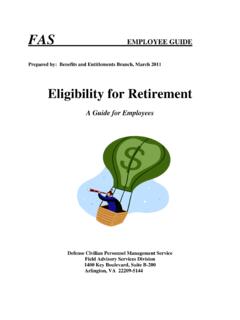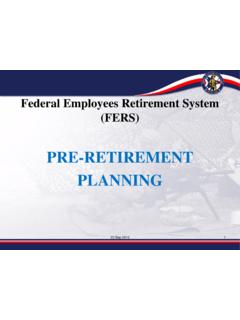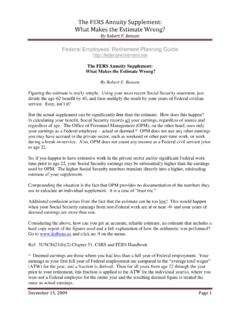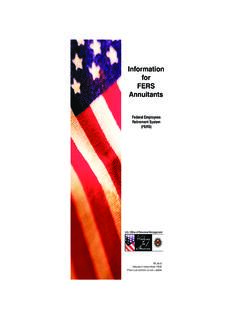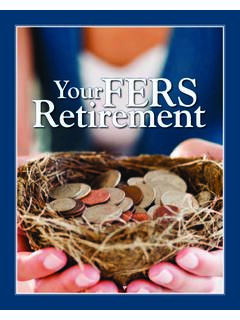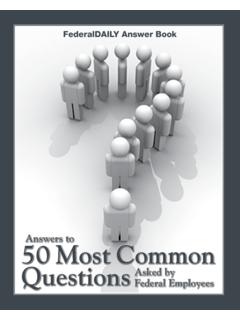Transcription of H.R. 3813 - Congressional Budget Office
1 Congressional Budget Office COST ESTIMATE February 9, 2012 3813 Securing Annuities for Federal Employees Act of 2012 As ordered reported by the House Committee on Oversight and Government Reform on February 7, 2012 SUMMARY 3813 would make several changes to the current retirement system for federal employees. Specifically, the legislation would increase the percentage of salary that federal employees in the Civil Service Retirement System (CSRS), Federal Employee Retirement System ( fers ), and smaller retirement systems are required to pay towards their retirement, make changes to the benefit formula used to calculate retirement annuities for certain employees, eliminate the fers retirement supplement that would be paid under current law to certain future retirees under the age of 62, and allow employees to contribute to their Thrift Savings Plan (TSP) accounts any payment received for accumulated and accrued annual leave.
2 CBO estimates that implementing the legislation would increase revenues by $42 billion and decrease direct spending by $2 billion over the 2012-2022 period. Pay-as-you-go procedures apply because enacting the legislation would affect direct spending and revenues. 3813 contains no intergovernmental mandates as defined in the Unfunded Mandates Reform Act (UMRA) and would impose no costs on state, local, or tribal governments. The bill would impose a private-sector mandate on federal workers under fers who are eligible by December 31, 2012 to retire and receive an annuity supplement and were not going to do so.
3 Because of a lack of information about the potential behavioral responses of individuals to such a change, CBO cannot determine whether the cost of the mandate would exceed the annual threshold established in UMRA for private-sector mandates ($146 million in 2012, adjusted annually for inflation). 2 ESTIMATED COST TO THE FEDERAL GOVERNMENT The estimated budgetary impact of 3813 is shown in the following table. The impacts of this legislation fall within all functions of the Budget . By Fiscal Year, in Millions of Dollars 2012 2013 2014 2015 2016 2017 2018 2019 2020 2021 20222012-20172012-2022 CHANGES IN REVENUESa Estimated Revenues 0 1,163 2,342 3,470 3,977 4,305 4,664 5,060 5,4655,898 5,807 15,257 42,151 CHANGES IN DIRECT SPENDINGb Estimated Budget Authority 0-24-89-134-176-213-242-266-298-338-390- 636 -2,169 Estimated Outlays 0-24-89-134-176-213-242-266-298-338-390- 636 -2,169 NET INCREASE OR DECREASE (-)
4 IN THE DEFICIT FROM CHANGES IN DIRECT SPENDING AND REVENUES Impact on Deficit 0 -1,187 -2,430 -3,604 -4,153 -4,518 -4,906 -5,325 -5,763 -6,235 -6,197 -15,893 -44,320 CHANGES IN SPENDING SUBJECT TO APPROPRIATIONb Estimated Authorization Level 0 -1,175 -2,353 -3,478 -3,986 -4,315 -4,676 -5,074 -5,481-5,916 -5,827 -15,306 -42,281 Estimated Outlays Memorandum 0 -1,175 -2,353 -3,478 -3,986 -4,315 -4,676-5,074 -5,481 -5,916 -5,827 -15,306 -42,281 Reduction in Offsetting ReceiptsResulting from Lower Employer Contributionsc 0 1,175 2,353 3,478 3,986 4,315 4,676 5,074 5,481 5,916 5,827 15,306 42,281 Sources: Congressional Budget Office and Joint Committee on Taxation.
5 A. For revenues, positive numbers indicate a decrease in the deficit. b. For direct spending and changes in spending subject to appropriation, negative numbers indicate a decrease in the deficit. c. Employer contributions are intragovernmental transactions that do not affect the deficit; positive numbers indicate a decrease in offsetting receipts. BASIS OF ESTIMATE CBO estimates that 3813 would increase revenues by $42 billion over the 10-year period, stemming mostly from changes to the retirement contribution rates for federal employees ($43 billion), offset slightly by lower revenues ($367 million) from a proposal to allow employees to contribute any payment received for accumulated annual leave to their TSP accounts.
6 3 Proposed reductions in the rates that agencies pay into the Civil Service Retirement and Disability Fund (CSRDF) on behalf of their employees would reduce spending subject to appropriations by $42 billion over the 2012-2022 period, CBO estimates; those lower payments from agencies would also reduce the amount of offsetting receipts received by the CSRDF; together those changes would have no impact on the deficit. However, since discretionary spending is currently subject to caps through 2021 (as specified in the Budget Control Act of 2011 Public Law 112-25) and the legislation does not reduce those caps, CBO assumes the reductions in such spending would not result in a net decrease in discretionary funding.
7 CBO also estimates that 3813 would reduce direct spending by $2 billion over the 2012-2022 period, as a result of eliminating the fers annuity supplement for certain employees who retire before the age of 62 ($ billion) and because of proposed changes to the retirement formula for federal employees ($274 million). Changes in Employee and Agency Contributions 3813 would increase the required contribution rate paid by federal employees and Members of Congress (in both CSRS and fers ) for their retirement by percent of salary, phased in over three years ( percent per year), beginning in January 2013.
8 Under current law, most CSRS employees contribute 7 percent of their salary towards retirement and most fers employees contribute percent. The proposed rate increase would apply to all employees and Members with 5 or more years of federal service as of January 1, 2013. For employees and Members who begin service on that date or later and have less than five years of prior federal service, 3813 would create a new retirement category of secure annuity employees. Such employees would be subject to a different contribution rate than CSRS and fers employees: secure annuity employees would be required to pay 4 percent of their salary towards retirement (under current law this group would pay percent of salary).
9 A rate of percent would apply to certain occupational groups such as law enforcement officers, firefighters, air traffic controllers and nuclear materials couriers who receive a higher pension benefit (the rate for this group under current law is percent of salary). For the purposes of this estimate, CBO assumes that the current population of approximately million federal employees will be maintained throughout the period. As employees in place as of January 1, 2013, retire or otherwise withdraw from federal service, CBO assumes they would be replaced, in equal number, by secure annuity employees.
10 The estimated annual rate of attrition for the group in place as of January 2013 increases from 17 percent in 2013 to 22 percent by 2022 for CSRS employees. The attrition rate for fers employees is lower, ranging from 5 percent to 13 percent over the same time period, because of differences in the average age of each group. 4 3813 specifies that the following additional retirement systems must conform with the provisions outlined in the legislation: the Foreign Service Retirement System, the Central Intelligence Agency Retirement and Disability System, and any defined benefit program that covers employees of the Tennessee Valley Authority.
